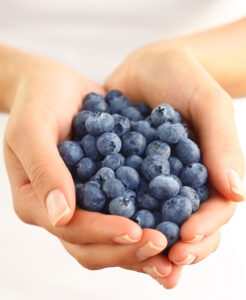By Lisa Salmon
A healthy balanced diet isn’t just about what you eat, it’s about portion size too – and it can be surprisingly easy to consume too much. According to The British Nutrition Foundation (BNF), on average, we’re eating 200-300 calories more than we need every day.
BNF research found 41 per cent of people tend to finish everything on their plate, even if they’re full. And while more than three-quarters (78 per cent) of those surveyed said they have portion sizes on their mind when preparing and serving meals, 20 per cent serve themselves large portions at mealtimes, to make sure they don’t feel hungry afterwards.
And when eating less healthy snacks like chocolate or crisps, 36 per cent said they let the occasion, their mood or hunger levels dictate the portions.

A generic stock photo to illustrate food, eating and portion sizes. Alamy/PA.
To help make it easier for people to understand what a healthy-sized amount looks like, without having to go to the trouble of weighing everything, the BNF has launched the new ‘Your balanced diet – get portion wise!’ on practical ways of measuring portion sizes for different foods and snacks.
“We want to remind people that eating a healthy diet isn’t just about what we eat, but also how much we’re putting on our plates,” says Sara Stanner, science director at the BNF. “Most of us will eat more when given bigger portions, so having portion sizes appropriate for our need is important.”
However, there are always exceptions to the rule – and portion sizes aren’t always a one-size-fits-all guide. “The portion sizes we give are a starting point – we’re all individuals with different needs,” Stanner adds. “For some foods, you can simply use your hands to measure the portions – it’s an easy way to ensure that larger people get bigger portions, and smaller people get less.”
Here’s a look at what the portion size measures include…
Fruit: About a handful or more. Vegetables: About 3 serving spoons or more
Fruit and vegetable portions are based on the 80g portions for 5 a Day. “For fruits and vegetables, the main message is to eat more,” stresses Stanner. “Usually, you can eat big portions of these for relatively few calories, so filling your plate with plenty of vegetables or having fruit-based puddings is a great way to have satisfying portion sizes for fewer calories.”
Cereal: About 3 handfuls
Around three handfuls of breakfast cereal is about 40g, which is around 200 calories with half a glass of semi-skimmed milk added. “Government guidance suggests having about 400 calories for breakfast, based on a calorie need of 2,000 calories a day,” she says. “So, you could choose to have a larger portion of cereal where your calorie needs are higher, or if you’re not having anything else for breakfast.”
Baked potato: About the size of your fist
A jacket potato the size of your fist will vary a lot between a large person and a small person, Stanner points out.
Dried rice or pasta: About 2 handfuls
It can be difficult to cook the right amount of pasta and rice, as they expand when cooking. “Allowing about two handfuls per person is a good place to start, but you can adapt this depending on who you are cooking for,” advises Stanner.
Chicken breast: About the size of your whole hand
A portion of grilled chicken breast about the size of your hand is approximately 120g and about 180 calories – although obviously this depends on the size of your hand, says Stanner. If you’re using chicken in a stir-fry or curry for example, you may find you need less as you’ll be including other ingredients.
Steak: About the size of your palm
For a lean grilled rump steak, this portion is about 130g and roughly 310 calories. “You don’t have to cut out red meat to have a healthy diet – it’s a source of important minerals such as iron and zinc,” she says. “But it’s a good idea to shift towards having more plant-based sources of protein.”
Dried lentils: About 2 handfuls
Two handfuls of dried lentils is about 50g, which equates to around 120g cooked weight. With canned lentils or other pulses, this is equivalent to half a standard can.
Nuts and seeds: About the amount you can fit in your palm
Nuts and seeds are nutrient rich but also high in calories, so it’s a good idea to be aware of your portion sizes if you’re concerned about your weight. Stanner says the amount that fits in your palm is about 20g and provides 113-137 calories.
Cheddar cheese: About the size of your two thumbs together
Stanner says: “You may find you don’t always want to stick to the portion sizes suggested – for example, if you’re a cheese lover and occasionally want to have more than two thumbs’ worth. But be aware that, depending on your needs, regularly eating large portions can make it more difficult to avoid weight gain.”







Click here to change your cookie preferences